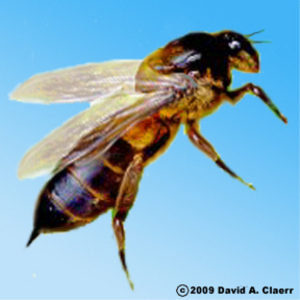“Killer Bees” also referred to as “Africanized Bees” by biologists and beekeepers, have been expanding their range into populated urban areas and cities in a northward expansion, as global warming raises the average annual temperatures. The nickname “Killer” originated in agricultural areas where livestock and even humans were killed by accidentally disturbed colonies of the bees.
Killer, or Africanized bees were first introduced into the Western Hemisphere by biologists, who imported them into Brazil in 1956, in an attempt to hybridize them with native species. But, in a real life version of a sci-fi experiment gone wrong, some of the African bees escaped into the wilds. The aggressive species, with a more robust and dominant genetic makeup began to interact with the native bees, supplanting them or cross-breeding with them. The hybrid bees expanded their range throughout both South and North America, reaching the United States in 1990 at Hildago, Texas.
The new hybrid variants retained the undesirable traits of the African imports. Not only do they produce less honey and beeswax than the European bees, now widely established in the Western Hemisphere, the Killer bees also are much more dangerous in that they launch a furious, sustained defense of their hives when disturbed.
Easily provoked by the approach of people and animals, or the sound and vibrations from machinery, the Africanized bee colony will launch an attack on those coming within 100 feet of the hive. The bees will persist in the assault for up to a quarter-mile distance away from the hive. A high percentage of the colony’s population join in the attack. Both the number of bees and the length of the time of the assault are much greater than that of the common European Honeybees, which are now used extensively used for production of honey and beeswax as well as for pollination of agricultural crops.
Experiments set up to compare the state of agitation in the bee and frequency of stings, measured by mechanical means, rated the severity of attacking Killer Bees at a 9 or 10 on a ten-point scale, versus a 1 or 2 rating for the European Honeybee. The bees are also provoked by strong odors and fragrances. Dark clothing and reflective jewelry are perceived as a threat, and the bees home-in on the carbon dioxide content in the exhaled breath of humans and animals. The best self-defense is to cover the head and neck with a shirt or jacket, and run swiftly away from the hive. Jumping into water is not recommended, as the bees will wait until you re-surface, and attack as you gasp for air.
There are other aspects of the bee’s range-expansion that bear mentioning. In another unforeseen twist of fate, in recent years, the European honeybees have suffered a sudden, major population loss, where whole colonies are obliterated by a combination of parasites and infecting microbes. The syndrome, called Colony Collapse Disorder, has spread throughout the U.S., paradoxically opening an ecological niche for the more resistant Killer Bees.
And yet another paradox enables the northward incursion. Human habitations and some of the supporting structures and mechanisms of our technological society have created micro-environments that are being used by the opportunistic Africanized bees to build their colonies. For example in the hot, arid environments of West Texas, New Mexico and Arizona cities, the bees will build hives in the underground housing of water-meters and valves, where a stable source of moisture and a moderate temperature range remains consistent year-round. In regions to the east and north, electrical transformer stations, generating warmth from the power lines, transformer units and circuits make an ideal location for weathering cold winters and more severe weather. The bees have been discovered in underground utility tunnels and within the physical plants that provide HVAC services for industrial complexes.
Killer, or Africanized bees are semi-migratory, swarming frequently to start new hives by dividing the population, or leaving in mass when abandoning old hives. They sometimes migrate in the autumn to head for warmer climates. But the rising temperatures induced by global warming has enabled them to increase their range ever
northward into the continental U.S., and they are now colonizing metropolitan areas with dense human populations.
In general, the presence of the Killer Bees is a lower-level hazard for the general population. But the situation is one that warrants more public awareness, and the activity of the Aricanized bees should be monitored more closely by the scientific community.
